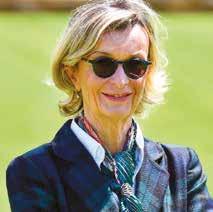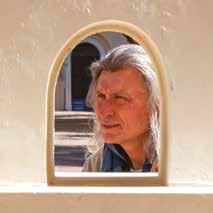
3 minute read
Contributours
from Equestrian Time 11
by alice3786
Irene Kung è conosciuta per le sue fotografie di monumenti da ogni parte del mondo che emergono dal buio. I simboli di Roma, New York, Buenos Aires, Mosca sono sospesi in una dimensione onirica dove l’architettura è l’unico elemento visibile.“Nelle sue immagini le cattedrali diventano palazzi celesti così come dovevano apparire ai fedeli, ignari di architettura e di scienza delle costruzioni. I monumenti conservano la loro identità e la loro collocazione geografica e tuttavia, nell’abbandonare la terra per innalzarsi verso l’inconscio, si liberano dalle loro apparenze culturali e funzionali per divenire mirabili astrazioni.”(Francine Prose, 2013).
All’inizio degli anni 2010 Irene ha iniziato a interessarsi alla Natura e agli alberi. A parole sue “Nel mio modo di lavorare è possibile riportare l’albero a quello che ho sentito. Il mio lavoro consiste proprio in questo: tolgo ciò che non è essenziale per far vedere l’albero com’è, come lo sento. È intuizione, è irrazionale: il razionale ci può portare fuori strada, il sentimento no.” Irene Kung vive e lavora in Svizzera.
Advertisement
Irene Kung is best known for her photographs of monumental architecture from cities around the world emerging from the dark. The symbols of Rome, New York, Buenos Aires, Moscow, are suspended in a dream-like state where only the architecture is visible. “In her photos, cathedrals become the heavenly palaces they must have seemed to the faithful who knew nothing of architecture and structural engineering. Monuments retain their identity and their geographical location, and yet in the process of leaving the earth to float upward into the unconscious, they shed the dry husks of culture and of purpose to become wondrous abstractions” (Francine Prose, 2013)
Since the beginning of the 2010s, her focus has shifted toward Nature and trees. In the artist’s words: “In my way of working it is possible to reinstate the tree to what I felt. That is exactly what I do with my work: I remove everything unessential in order to show the tree as it is, as I feel it. It is intuition, it is irrational: rationality can be misleading, sentiment cannot. Irene Kung lives and works in Switzerland.
Romana, Caterina Vagnozzi dagli anni ’70 è una giornalista freelance specializzata in sport equestri. Dal 1987 è membro dell’International Alliance of Equestrian Journalist e delegata nazionale per l’Italia dal 2010. È sempre stata legata al mondo equestre; prima come amazzone poi come allevatrice. All’inizio degli anni ’90 ha fondato Equi-Equipe, una società che fornisce servizi editoriali legati ai più importanti eventi equestri. Dalla fine degli anni ’70 ha dato il suo contributo alle principali testate sportive italiane: Corriere dello Sport, Gazzetta dello Sport e anche al quotidiano Il Messaggero.

Cavalli e natura da sempre nel cuore, Caterina affianca all’attività di giornalista quella di imprenditrice con la conduzione dell’azienda agricola biologica di famiglia, in Sabina, alle porte di Roma.
Based in Rome, Caterina Vagnozzi has been a freelance journalist specializing in equestrian sports since the 1970s. She has been a member of the International Alliance of Equestrian Journalists since 1987 and national delegate for Italy since 2010.She has always been tied to equestrian world, originally as a horsewoman, then a breeder. At the beginning of the 1900s she founded Equi-Equipe, a company providing editorial services connected to big equestrian events. Since the late 1970s she has been a constant contributor to the main Italian sport tabloids. Corriere dello Sport and Gazzetta dello Sport, and also to the broadsheet Il Messaggero.
With horses and nature in her heart, Caterina is not only a journalist but also an agricoltural entrepreneur running the family biological farm in the Sabine Hills near Rome.
Stefano Conticelli vive e lavora a Castel Giorgio di Orvieto, a stretto contatto con la natura generosa della terra d’Umbria, la sua terra, dove, come art designer, fonda Bottega Conticelli nel 2007. È attratto dai materiali naturali quali il cuoio, il legno, la lana, la juta, il ferro: di essi impara a conoscere sin da piccolo tutti i segreti e a lavorarli con maestria, trasformandoli in oggetti sempre originali e inediti, che catturano presto l’attenzione di estimatori del bello contemporaneo.

Oltre ad improntare l’attività creativa della Bottega Conticelli, negli ultimi anni Stefano ha intrapreso una ricerca sperimentale più personale, realizzando opere uniche che danno voce alla parte più intima e profonda dei suoi pensieri e del suo sentire (Cheval Résonnant nel 2018, Save the Ocean nel 2019, Aria nel 2020).
Stefano Conticelli lives and works in Castel Giorgio di Orvieto, in close proximity to the generous nature of Umbria - his land, where, as an art designer, he founded Bottega Conticelli in 2007. He is attracted to natural materials such as leather, wood, wool, jute, and iron: since childhood, he has learned to know all their secrets and to skilfully mould and shape them so as to turn them into unique, original objects, which soon captured the attention of all connoisseurs of contemporary beauty. In addition to imprinting the creative activity of Bottega Conticelli, in recent years Stefano has undertaken more personal experimental research, creating unique works that give voice to the most intimate and in-depth nature of his thoughts and feelings (Cheval Résonnant, 2018; Save the Ocean, 2019; Aria, 2020).










